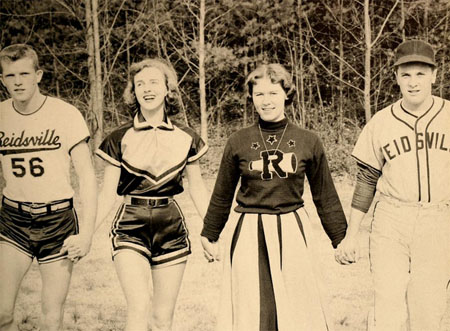A 1924 cookbook from Farmington, North Carolina has been digitized and added to DigitalNC, courtesy of our partner, the Davie County Public Library.
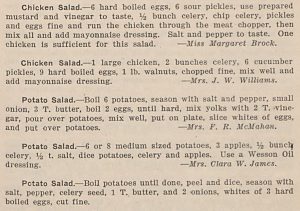
Sample recipes inside the cookbook for chicken and potato salad
Compiled and published in 1924 by the Ladies Aid Society of Farmington, this cookbook includes recipes and “tested receipts” for a wide variety of dishes, including soups, seafood, meats and appropriate sauces, breads, salads, sandwiches, desserts, drinks, cakes, and more. Some of the recipes included in the photo on the right are for chicken salad and potato salad, as well as their appropriate seasonings. It also includes “miscellaneous” advice on how to prepare and preserve eggs and how to cure meat, as well as unusual home remedies for coughs (sulfur), burns (turpentine), and chapped hands (melted soap and bran). We can’t attest to whether these home remedies work or not!
This cookbook represents a valuable new addition to our knowledge about Davie County in the early 20th century, as well as the knowledge women were passing around during the 1920s. To see more materials from Davie County Public Library, visit their contributor page or visit their website.
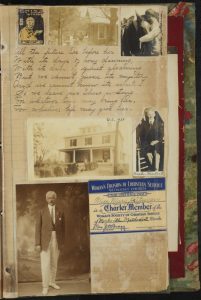
A page from Mary Jane Heitman’s scrapbook that includes photographs and memorabilia along with a handwritten poem musing about the future.
New materials from Davie County Public Library are now up on DigitalNC, including a set of 6 journals by James McGuire Jr., a collection of photographs of Arden Farms in Forsyth County, and a scrapbook compiled by Mary Jane Heitman.
James McGuire Junior’s journals take the form of Gude’s Pepto-Mangan Physician’s Memorandum books. Each page corresponds to a day of the year, and includes a short medical fact, often related to Gude’s Pepto-Mangan medicine, along with a space to write. James McGuire Jr., a prominent business man in Mocksville, North Carolina, wrote many short entries recounting topics such as the weather, travel, social engagements, shopping lists, and finances. The memorandum books themselves most likely originated from James’ father, Dr. James McGuire, a physician.
Mary Jane Heitman’s scrapbook tells the story of her life in photographs, news articles, postcards, handwritten musings, and illustrations from 1891-1927. Mary Jane Heitman was a teacher and historian from Mocksville, North Carolina, and her scrapbook recounts with fondness both her time as a student and a teacher. Each page is poetically constructed, and photographs and descriptions of friends and relatives are distributed throughout. The last page of the scrapbook includes a written tribute by one of her students from Salem Academy that was added after her death in 1962.
To see more materials from Davie County Public Library, visit their partner page, or take a look at their website.
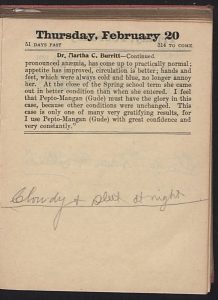
James McGuire Junior’s entry from February 20, 1902 that describes the weather as cloudy with sleet at night.
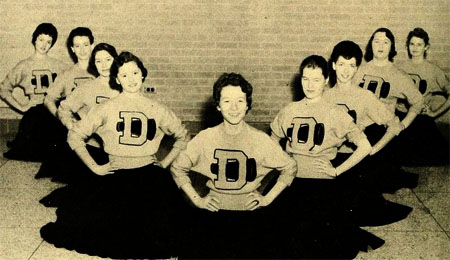
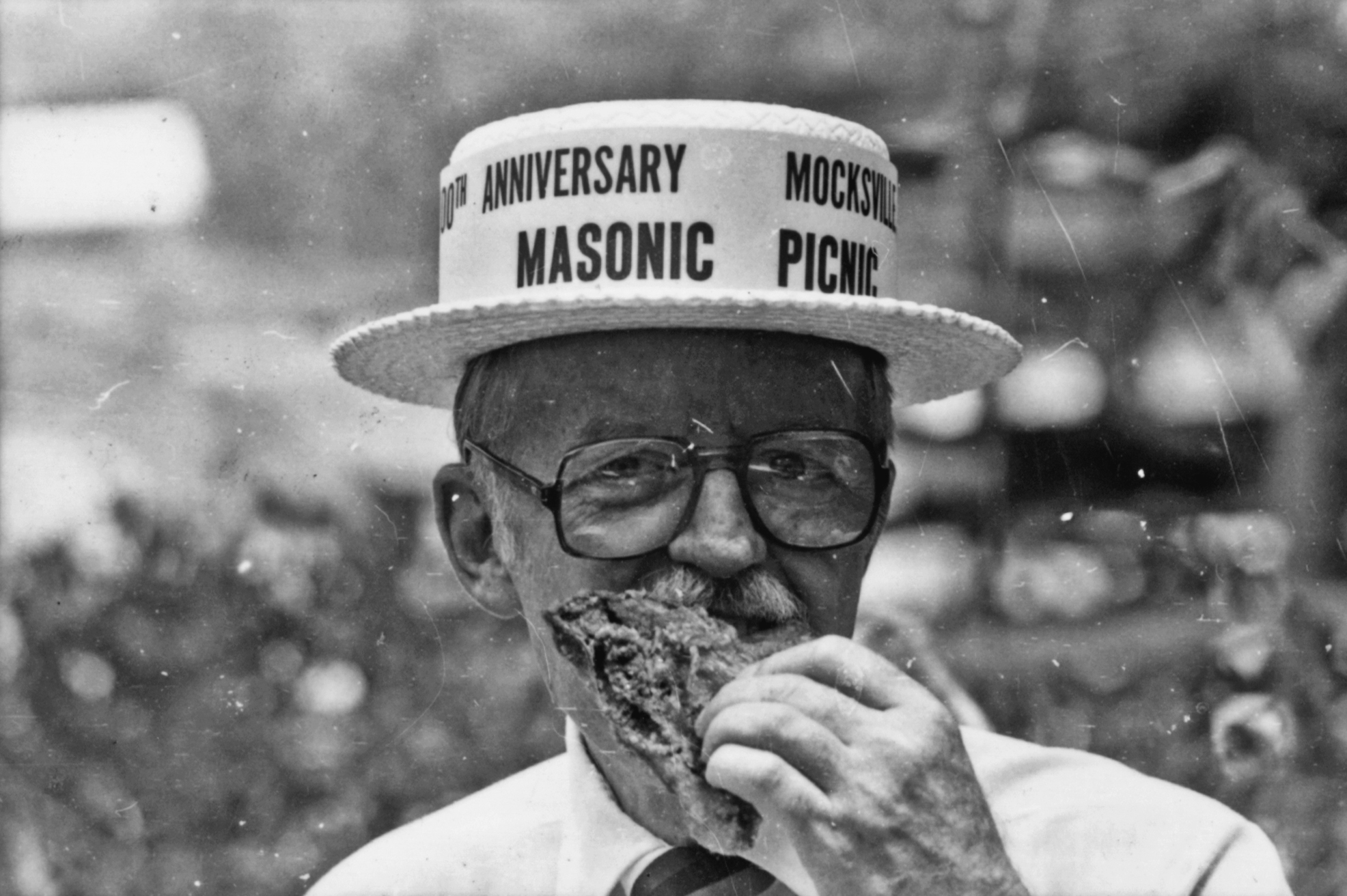
More historic photographs of Masonic Picnics have been added to the Digital Davie exhibit on DigitalNC. The first annual Masonic Picnic was held in 1884, and over the years the picnic has raised funds to support educational opportunities for local students, Davie Training School, and the Oxford Orphanage. Some photographs from Digital Davie relating to Masonic picnics depict prominent politicians from North Carolina, such as Governors Charles Aycock and Clyde Hoey and Senators Sam Ervin and Jesse Helms.
Items in Digital Davie are shared by the Davie County Public Library.
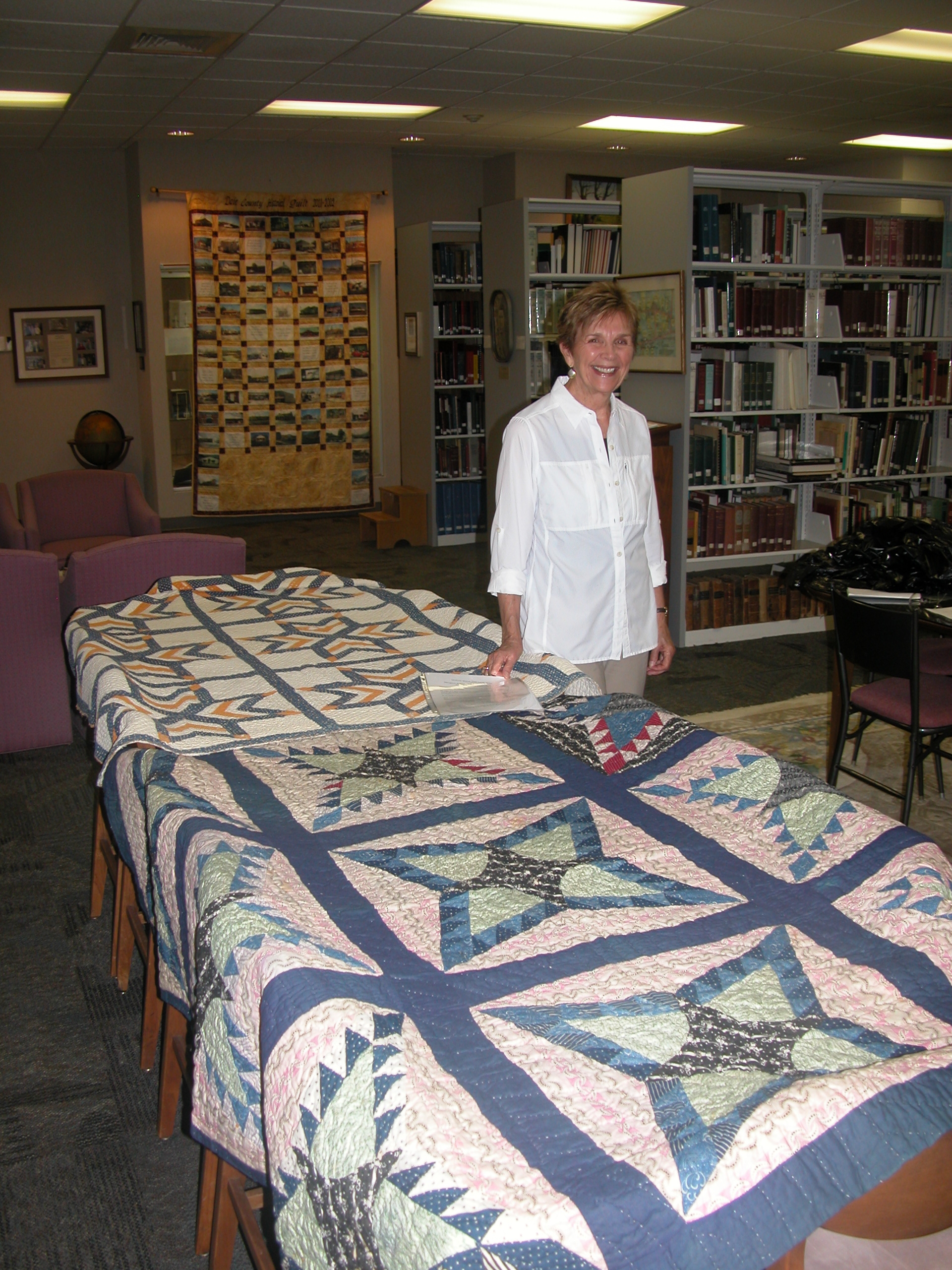
Here on DigitalNC we’ve got some up-to-the-minute stuff in addition to our historic materials – check out this photograph of two antebellum quilts donated to the Davie County Public Library earlier this very week.
And for the quilt enthusiasts, check out the other images of quilts on DigitalNC.org.
While North Carolina has fortunately not seen anything this year like the terrible floods currently affecting the Mississippi River, our state is no stranger to the tragedy and disaster caused by flooding. The Images of North Carolina collection currently has 98 different photos of floods and flood damage, showing floods in Rocky Mount, Ashe County, and Davie County.
This image, from the Charles S. Killebrew collection at the Braswell Memorial Library (Rocky Mount, N.C.), shows downtown Rocky Mount in 1962.

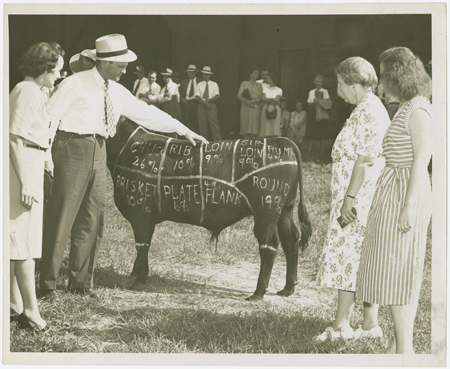 This photograph, from the Davie County Public Library, might be the most literal depiction of the phrase ‘beef on the hoof’ that I’ve ever seen. While these women were probably getting tips on what to ask for from the local butcher, I guess the cow had no idea what its future held in store. More images depicting the history and culture of Davie County can be found in the Digital Davie collection on DigitalNC.
This photograph, from the Davie County Public Library, might be the most literal depiction of the phrase ‘beef on the hoof’ that I’ve ever seen. While these women were probably getting tips on what to ask for from the local butcher, I guess the cow had no idea what its future held in store. More images depicting the history and culture of Davie County can be found in the Digital Davie collection on DigitalNC.

This week we have the final 35 newspaper titles for this project up on DigitalNC! Over the past 11 months we have uploaded over 2.4 million pages of North Carolina newspapers – bringing our total number of newspaper pages on DigitalNC to 4,175,076 and our total number of titles on DigitalNC to 1,161 – all freely available to anyone! In this closing batch we have our first paper from Bower, North Carolina (which you may know as Clemmons today) and an article in the Union Republican about Stokes County’s would be Wright brother: Jacob A. Hill.
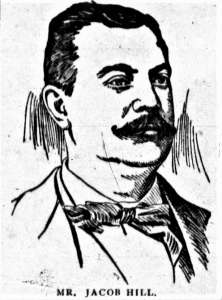
Jacob Hill, Winston-Salem Journal, March 9, 1902
Before Orville and Wilbur’s iconic first flight in 1903, the race to create a manned flying machine was fiercely competitive. One of the contenders was a man from Vade Mecum Springs named Jacob Hill. Hill was born 1862 in Davie County and had been fascinated by the flight of birds ever since he was a child. In 1901 he decided to take that curiosity a little further and solve “the problem of aerial navigation” by building his own dirigible.
-
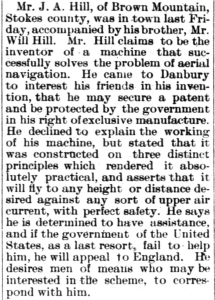
-
Union Republican, March 14, 1901
-
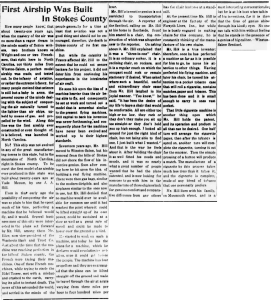
-
Danbury Reporter, December 5, 1923
Mr. Hill’s machine could have been the first piloted aircraft, but we’ll never know for sure if it could actually fly and be controlled. Momentum ran out when Hill couldn’t secure funding for his invention. According to Thomas Parramore’s First to Fly, witnesses claimed the craft could get off the ground, but couldn’t do much more than hover in place. Even though Hill’s airship became something of a local joke for a time, the legacy of his wild aspirations continues to live on in North Carolina history.
-
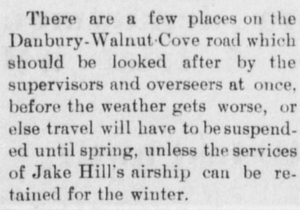
-
Danbury Reporter, December 15, 1904
-
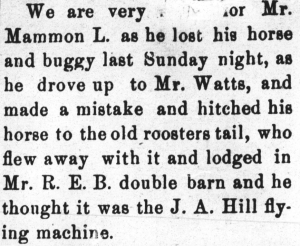
-
Business Guide, February 16, 1906
Over the past year, we’ve added millions of newspaper images to DigitalNC. These images were originally digitized a number of years ago in a partnership with Newspapers.com. That project focused on scanning microfilmed papers published before 1923 held by the North Carolina Collection in Wilson Special Collections Library. While you can currently search all of those pre-1923 issues on Newspapers.com, we have made them available in our newspaper database as well. This will allow you to search that content alongside the 2 million pages already on our site – all completely open access and free to use.
This week’s additions include:
Belhaven
Bower
Charlotte
Greensboro
Kings Mountain
Kinston
Lenoir
Monroe
Mt. Airy
New Bern
- The Republic and Courier (New Bern, N.C.) – 1872-1874
- The True Republican, and Newbern Weekly Advertiser (New Bern, N.C.) – 1810-1811
- The Morning Herald (New Bern, N.C.) – 1807-1808
- Newbern Herald (New Bern, N.C.) – 1809-1810
- The North Carolina Circular, and Newbern Weekly Advertiser (New Bern, N.C.) – 1803-1805
- The Daily Herald (New Bern, N.C.) – 1868
- The Republican & Courier (New Bern, N.C.) – 1871
- Newbern Enquirer (New Bern, N.C.) – 1860
- The Daily Journal (New Bern, N.C.) – 1894
- New Berne Daily Journal (New Bern, N.C.) – 1894-1895
Salem
Salisbury
Shelby
Statesville
Swan Quarter
Taylorsville
Warrenton
Winston
Winston-Salem
If you want to see all of the newspapers we have available on DigitalNC, you can find them here. Thanks to UNC-Chapel Hill Libraries for permission to and support for adding all of this content as well as the content to come. We also thank the North Caroliniana Society for providing funding to support staff working on this project.
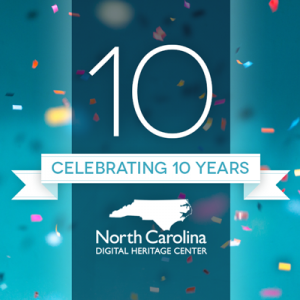 It’s DigitalNC.org’s 10th birthday! Though we had hoped to be in the office celebrating, we’re still taking time to look back at years of hard work and the collaborative spirit that makes the North Carolina Digital Heritage Center (NCDHC) what it is!
It’s DigitalNC.org’s 10th birthday! Though we had hoped to be in the office celebrating, we’re still taking time to look back at years of hard work and the collaborative spirit that makes the North Carolina Digital Heritage Center (NCDHC) what it is!
To date, NCDHC has partnered with 273 libraries, museums, alumni associations, archives, and historic sites in 98 of North Carolina’s 100 counties and we’re growing all the time. Our website currently includes 4.2 million images and files. We share this accomplishment with every institution we’ve worked with. We’d never have gotten to 10 years without staff (permanent, temporary, and student!), our partners, or the network of colleagues all over North Carolina who have encouraged, advised, and supported our work.
As we approached our anniversary, we realized that our website lacked a synopsis of how NCDHC came to be, and our history. So read on for a brief look at how we got started and our major milestones.
Our History
The North Carolina Digital Heritage Center was one outcome of a comprehensive effort by the state’s Department of Cultural Resources (now the Department of Natural and Cultural Resources) to survey and get a broad overview of the status of North Carolina cultural heritage institutions. That effort was entitled NC ECHO (North Carolina Exploring Cultural Heritage Online) and was funded by the Institute of Museum and Library Services (which also supports us – thanks IMLS). A major goal of NC ECHO was a multi-year needs assessment. NC ECHO staff visited hundreds of cultural heritage institutions throughout the state to collect data and interview curators, librarians, volunteers, archivists, and more. Many of our partners still remember their visits!
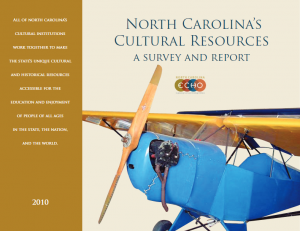 Data collected at these site visits was combined with survey responses to reveal a “state of the state,” summarized in a 2010 report, cover pictured at right. The assessment revealed a lot but, specific to digitization, staff found that nearly three-quarters of the 761 institutions who completed the survey had no digitization experience or capacity. Members of the Department of Cultural Resources (which includes the State Library, State Archives, and multiple museums and historic sites) began brainstorming with other area institutions about a way to help efficiently and effectively provide digitization opportunities. While the NC ECHO project offered digitization grants, workshops, and best practices, an idea emerged of a centralized entity that could assist institutions that didn’t have the capacity to do the work in house. The State Library of North Carolina and UNC-Chapel Hill Libraries joined together to create such an entity: the North Carolina Digital Heritage Center. The Center would be located in Chapel Hill, taking advantage of its central location and the digitization equipment and expertise already available in Wilson Special Collections Library. The State Library would provide funding, guidance, and ongoing promotion and support of the Center’s services.
Data collected at these site visits was combined with survey responses to reveal a “state of the state,” summarized in a 2010 report, cover pictured at right. The assessment revealed a lot but, specific to digitization, staff found that nearly three-quarters of the 761 institutions who completed the survey had no digitization experience or capacity. Members of the Department of Cultural Resources (which includes the State Library, State Archives, and multiple museums and historic sites) began brainstorming with other area institutions about a way to help efficiently and effectively provide digitization opportunities. While the NC ECHO project offered digitization grants, workshops, and best practices, an idea emerged of a centralized entity that could assist institutions that didn’t have the capacity to do the work in house. The State Library of North Carolina and UNC-Chapel Hill Libraries joined together to create such an entity: the North Carolina Digital Heritage Center. The Center would be located in Chapel Hill, taking advantage of its central location and the digitization equipment and expertise already available in Wilson Special Collections Library. The State Library would provide funding, guidance, and ongoing promotion and support of the Center’s services.
At its beginning, the Center’s staff digitized small collections of college yearbooks, needlework samplers, postcards, and photographs and made them available through DigitalNC.org. They went to speak with organizations interested in becoming partners, and began taking projects for digitization. Here’s a list of NCDHC’s earliest partners, who came on board during late 2009 and 2010.
Though we’re not positive of the exact date, we believe DigitalNC.org launched on or near May 12, 2010. Here’s a look at that original site!
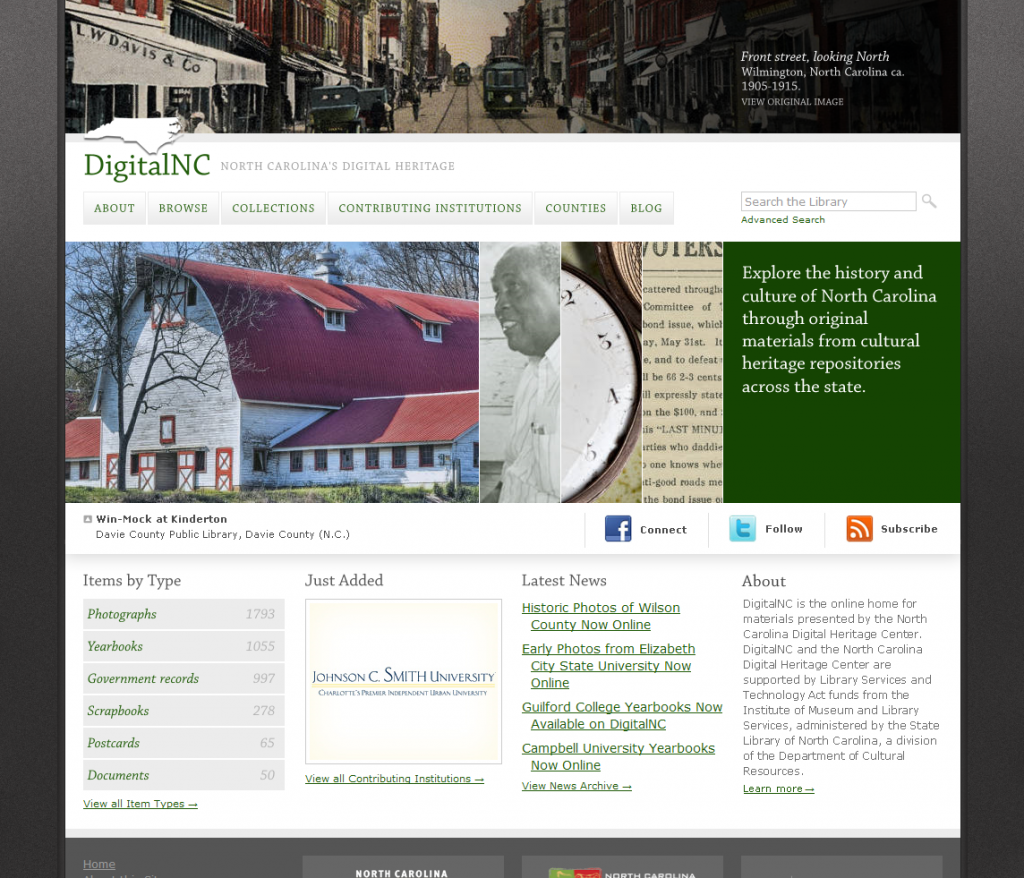
In 2011, word about the Center spread. Staff started responding to demand from partners, incorporating newspaper digitization. In late 2012, also in response to popular demand, the Center began digitizing high school yearbooks. Yearbooks and newspapers are some of the most viewed items on DigitalNC, and they remain a significant portion of our work to this day.
In 2013, NCDHC joined the Digital Public Library of America (DPLA) as North Carolina’s “service hub.” The DPLA collects information from digitized collections all over the nation and provides it together in one searchable interface at dp.la. Because of our participation, users can browse and search for collections from North Carolina alongside items from institutions around the country.
Throughout the years, we’ve tried to expand services to fit our partners’ goals. In 2015, we trialed an audiovisual digitization project that incorporated the first films into DigitalNC. Today, we partner with the Southern Folklife Collection at Wilson Special Collections Library to provide audio digitization on an ongoing basis. In 2016, we added a new partner category – alumni associations – to support more digitization of African American high school yearbooks and memorabilia. The following year, we announced a focus on digitization of items documenting underrepresented communities. We also started going on the road with our scanners! For institutions that don’t have the staff time or resources to travel to Chapel Hill, we offer to come for a day or two and scan on site.
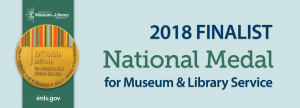 2018 and 2019 saw several major milestones. We were nationally recognized as an Institute of Museum and Library Services National Medal finalist, and we began a major software migration. Both were a tribute to the size and extent of our operation, though in different ways. As we’ve approached our 10th anniversary we’ve focused on working with partners in all 100 of North Carolina’s counties. Whether you’re rural or metropolitan, we believe your history is important and should be shared online.
2018 and 2019 saw several major milestones. We were nationally recognized as an Institute of Museum and Library Services National Medal finalist, and we began a major software migration. Both were a tribute to the size and extent of our operation, though in different ways. As we’ve approached our 10th anniversary we’ve focused on working with partners in all 100 of North Carolina’s counties. Whether you’re rural or metropolitan, we believe your history is important and should be shared online.
One of the ways we’re commemorating this anniversary is to ask our partners and stakeholders how they think we’ve impacted them and their audiences. Join us here on the blog in the second half of 2020 as we share these brief interviews, reflect, and celebrate. Thank you for reading, enjoy the site, and here’s to another 10 years of making North Carolina’s cultural heritage accessible online!
A new video has been digitized and added to DigitalNC, courtesy of our partner, Davie County Public Library. The original 16mm film shows Dr. S. Clay Williams Jr. walking around the garden at Willsherr Lodge on Win-Mock Farm in uniform in 1945. Click here to view the film.
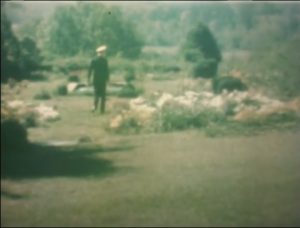
A frame from the video, showing Dr. S. Clay Williams Jr walking in the garden
Win-Mock Farm is a plot of land along the Yadkin River built by S. Clay Williams, president of the R.J. Reynolds Tobacco Company, located halfway between Winston-Salem and Mocksville. The Willsherr Lodge acted as the large family home, which is very briefly visible in the film.
To learn more about Win-Mock Farm, their website is here. To see more materials from Davie County Public Library, visit their partner page, or take a look at their website.




